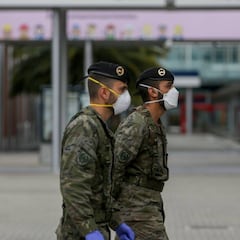Coronavirus: what have been the worst pandemics and epidemics in history?
In five months, the Covid-19 pandemic has claimed 153,793 lives globally. But the world has suffered other deadlier pandemics, epidemics and plagues through history.

Since the first positive case of novel Coronavirus infection in China towards the end of last year, the ensuing Covid-19 pandemic has claimed the lives of 153,793 people around the world and affected over two million others.
It is not the first time that the world has had to deal with hitherto unknown viruses and diseases, epidemics and pandemic infecting and killing on a large scale. There have been other coronavirus outbreaks – some even quite recently like the SARS and MERS epidemics. The 1918 Flu pandemic, erroneously labelled the Spanish Flu pandemic is thought to have infected up to a quarter of the world’s population and left between 17 and 50 million dead.
Here are some of the epidemics and pandemics of recent times and other major ones further back in history.
West African Ebola virus epidemic: 2013-2016
Parts of West Africa suffered the worst Ebola virus outbreak ever recorded with the epidemic lasting from December 2013 until January 2016. A true figure on the number of infections and deaths is difficult to ascertain as many cases went unreported but officially, there were 28,616 reported cases and 11,310 deaths. It is believed that bats played a role in the transmission of Ebola, which is spread from human to human by bodily fluids. After starting in Guinea, the disease spread to Liberia and Sierra Leone – the three most heavily-affected countries. The epidemic was contained through contact tracing and hygiene awareness programmes and was practically eradicated by January 2016 but as there is no cure, it could return.
H1N1 Swine Flu pandemic: 2009-2010
Unlike Covid-19, swine flu affects mainly the young and healthy but not as deadly as some of the previous viral pandemics, with a mortality rate of around 0.01%. Older people, who have suffered flu during their lives, are more likely to be immune. It is an airborne virus that is transmitted through coughing and sneezing or by contact of virus droplets then ingestion. The H1N1 virus affected around 700 million people across the planet with around 18,500 deaths. By November of 2009 a vaccine was in general use but like most flu strains, in most cases it passes with adequate rest and by drinking liquids.
Asian Flu: 1957-1958
The Asian Flu pandemic, a strain of the H2N2 avian influenza virus, claimed more than one million lives worldwide, the majority in Latin America. The virus spread rapidly following the outbreak in China, affecting Hong Kong, the UK then the United States. The virus had a low mortality rate but was particularly dangerous for pregnant women and the elderly. It was contained when a vaccine was licensed by which time, the virus had mutated to H3N2, which caused another pandemic in 1968.
1918 Flu pandemic or Spanish Flu pandemic: 1918-1920
The First World War was one of the main catalysts for the 1918 Flu epidemic which spread with ease throughout the heavily congested trenches of Belgium and France and field hospitals treating wounded soldiers. Around 500 million people are believed to have been infected across two waves of the H1N1 virus – it killed anywhere from between 17 and 50 million but scientists believe it was no more deadly than other strains but conditions, overcrowded hospitals and poor diet, allowed it to spread like wildfire.
It has been called Spanish Flu even though it did not start in Spain, but the first newspaper reports of the epidemic were reported there.

Great Plague of London: 1665-1666
Related stories
This was the last of several major epidemics of bubonic plague in England, which lasted around a year and a half and killed approximately 100,000. It was spread by infections caused by bites on the skin from fleas living on infected black rats. It entered the UK from merchant ships, possibly via the Netherlands and lasted until 1666 when the last traces of the disease were probably wiped out by the Great Fire of London.
The Black Death: 1347-1351
The largest and most destructive pandemic in history resulted in the deaths of between 75 and 200 million people across the globe. A perfect storm of weather and economic conditions, coupled with poor hygiene of the day, enabled the plague epidemic to escalate. Black rats were the carriers of the plague and the virus was spread by the fleas which lived on them, moving onto new hosts - other animals and humans. It has a case fatality rate of around 11% so is much deadlier than coronavirus but it can be treated with antibiotics.

